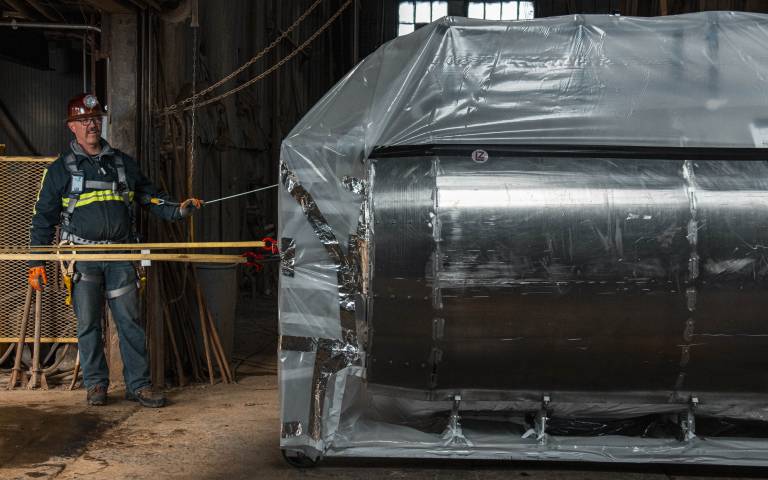Particle detector for hunting dark matter installed a mile underground
29 October 2019
The central component of LUX-ZEPLIN (LZ) – the largest direct-detection dark matter experiment in the US – has been slowly lowered 4,850 feet down a shaft formerly used in gold-mining operations by a team involving UCL physicists.

Although dark matter accounts for about 27 percent of the universe, we do not know what it is made of and experiments have yet to make direct contact with a particle – it has only been detected through its gravitational effects on normal matter.
Once operational next year, the LZ aims to change this by hunting theorised dark matter particles called WIMPs, or weakly interacting massive particles. It is 100 times more sensitive than its predecessor experiment, called LUX, which operated in the same underground space.
Professor Cham Ghag (UCL Physics & Astronomy), UCL LZ collaboration scientist, said: “Understanding the nature of the elusive dark matter is recognized as one of the highest priorities in science and we are building the most sensitive machine yet to detect WIMPS, which are the leading theoretical candidate for a dark matter particle.
“If WIMPS exist, billions of particles pass through your hand every second but to directly hunt this mysterious particle, we have to bury our detector deep underground to shield it from all the other particles which steadily bombard Earth’s surface.”
Last week, crews at the Sanford Underground Research Facility (SURF) in South Dakota strapped the
5,000-pound, 9-foot-tall particle detector to its resting place following extensive planning and two test moves of a “dummy” detector to ensure its safe delivery.
Theresa Fruth, a postdoctoral research fellow at UCL Physics & Astronomy who works on LZ’s central detector, said that keeping LZ sealed from any contaminants during its journey was a high priority as even the slightest traces of dust and dirt could ultimately affect its measurements.
“From a science perspective, we wanted the detector to come down exactly as it was on the surface,” she said. “The structural integrity is incredibly important, but so is the cleanliness, because we've been building this detector for 10 months in a clean room. Before the move, the detector was bagged twice and inserted in the transporter structure. Then, the transporter was wrapped with another layer of strong plastic. We also need to move all our equipment underground so we can do the rest of the installation work underground.”
The central detector, known as the LZ cryostat and time projection chamber, will ultimately be filled with 10 tons of liquid xenon chilled to minus 148 degrees Fahrenheit. Scientists hope to capture flashes of light that are produced when dark matter particles interact with the heavy xenon atoms in this cryostat.
Dr Pawel Majewski from the Particle Physics Department of the UK’s Science and Technology Facilities Council has led the design, fabrication, cleaning, and delivery of LZ’s inner cryostat vessel and said, “It is extremely gratifying to finally see the unit holding the heart of the LZ experiment at last resting in its final place in the Davis Campus, one mile underground. The cryostat itself is a feat of engineering and the UK team have had to meet some very stringent and challenging requirements in building it, most particularly in making it from ultra-radio-pure titanium because of the huge mass of the cryostat – 2,000kgs.”
To limit false signals of unwanted particle “noise”, the LZ’s cryostat will be surrounded by a tank filled with a liquid known as a scintillator, which in turn will be embedded within a large water tank that provides a further buffer layer.
Murdock “Gil” Gilchriese, LZ project director and a physicist at Lawrence Berkeley National Laboratory (Berkeley Lab), which is the lead institution for the LZ project, said, “Next, the cryostat will be wrapped with multiple layers of insulation, and a few other exterior components will be installed. Then it will get lowered into the outer cryostat vessel. It will take months to hook up and check out all of the cables and make everything vacuum-tight.”
Most of the LZ work is now concentrated underground, with the team working multiple shifts to complete the LZ assembly and installation. UCL is playing a key role in getting the core of the detector up and running for data taking, and then data analysis.
There are plans to begin testing the process of liquefying xenon gas for LZ in November using a mock cryostat, and to fill the actual cryostat with xenon in spring 2020. Project completion could come as soon as July 2020.
Links
- Prof Cham Ghag's academic profile
- Theresa Fruth's academic profile
- UCL High Energy Physics
- UCL Physics & Astronomy
- Lux-Zeplin UK Collaboration
Image
- The central detector is sealed and wrapped in plastic to prevent contamination during the decent. (Credit: Erin Broberg/Sanford Underground Research Facility)
Media contact
Bex Caygill
Tel: +44 (0)20 3108 3846
Email: r.caygill [at] ucl.ac.uk
 Close
Close

